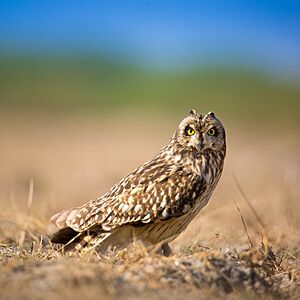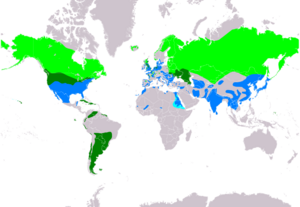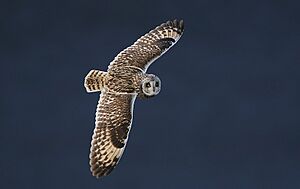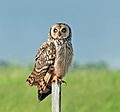Short-eared owl facts for kids
Quick facts for kids Short-eared owl |
|
|---|---|
 |
|
| An owl in the Little Rann of Kutch. | |
| Conservation status | |
| Scientific classification | |
| Genus: |
Asio
|
| Species: |
flammeus
|
 |
|
| Where A. flammeus lives Breeding Resident Passage Non-breeding | |
| Synonyms | |
|
|
The short-eared owl (Asio flammeus) is a type of owl found all over the world. It lives in open areas like grasslands. These owls are part of the Strigidae family. Owls in the Asio group are called "eared owls." This is because they have feather tufts that look like ears. These tufts are not always easy to see. The short-eared owl shows its tufts when it feels threatened.
Contents
About the Short-Eared Owl
The short-eared owl was first officially described in 1763. This was done by a bishop named Erik Pontoppidan. He gave it the name Strix flammea. The word flammeus comes from Latin. It means "flame-coloured." This owl now belongs to the genus Asio. This group was named by Mathurin Jacques Brisson in 1760. There are several types, or subspecies, of short-eared owls. They live in different parts of the world.
What They Look Like
The short-eared owl is a medium-sized owl. It is about 34–43 cm (13–17 in) long. It weighs between 206–475 g (7.3–16.8 oz). These owls have big eyes and a large head. They also have a short neck and wide wings. Their beak is short, strong, and black.
Their feathers are a mix of brown and tan colors. Their tail and wings have stripes. The upper part of their chest has many streaks. When they fly, their wingbeats are uneven. This makes their flight look a bit floppy. Some people say they fly like a moth or a bat. Their wings can spread from 85 to 110 cm (33 to 43 in). Female owls are a little bigger than males.
The short-eared owl has bright yellow-orange eyes. Black rings around their eyes make them look even bigger. These rings look like they are wearing mascara. White feathers around their eyes form a mask-like shape.
Owl Sounds
Short-eared owls make a harsh, bark-like sound. They often make raspy waowk, waowk, waowk sounds. They also make toot-toot-toot-toot-toot noises. When they are breeding, you might hear a loud eeee-yerp. However, these owls are usually quiet in winter.
How to Tell Them Apart from Long-Eared Owls
The short-eared owl looks a lot like the long-eared owl. Both owls live in many of the same places. When resting, the long-eared owl's ear-tufts are usually easy to see. This helps tell them apart. But sometimes, long-eared owls can flatten their tufts.
Here are some other differences:
- Eye Color: Short-eared owls have yellow eyes. Long-eared owls have orange eyes.
- Eye Markings: The black around the short-eared owl's eyes goes across horizontally. On the long-eared owl, it goes up and down vertically.
- Feather Color: Short-eared owls are usually lighter and sandier in color.
- Wings: Short-eared owls often have a wide white band on the back edge of their wings. Long-eared owls do not.
- Streaks: Short-eared owls have streaks only on their upper chest. Long-eared owls have streaks all over their underside.
- Habitat: Long-eared owls often hide in thick wooded areas. Short-eared owls prefer open fields. You can often see short-eared owls flying and hunting in the early morning or late afternoon.
Where They Live
The short-eared owl lives on every continent except Antarctica and Australia. This means it is one of the most widespread birds in the world. They breed in Europe, Asia, North and South America, the Caribbean, Hawaii, and the Galápagos Islands.
These owls are partly migratory. This means they fly south in winter from colder northern areas. Short-eared owls are known to move to places where there are more voles. Voles are small rodents that they like to eat. They will also travel around to find better food supplies. This happens especially in years when vole numbers are low.
They are found in many countries around the world. These include the United States, Canada, Mexico, many countries in Europe, and parts of Asia and South America.
Life and Behavior
Reproduction and Family Life
Short-eared owls can start having babies when they are one year old. In the northern parts of the world, their breeding season is from March to June. It is busiest in April. During this time, these owls might gather in groups.
Male owls perform amazing flights to attract females. The male will swoop down over the nest. He flaps his wings in a special dance to impress the female. These owls usually stay with one partner.
Short-eared owls build their nests on the ground. They choose open areas like prairies, tundras, or meadows. They hide their nests with low plants. The nests might have a light lining of weeds, grass, or feathers. A typical nest has about 4 to 7 white eggs. But if there are lots of voles, they might lay up to 12 eggs! They usually have one group of babies each year.
The female owl does most of the egg incubation. This takes about 21 to 37 days. The young owls leave the nest when they are a little over four weeks old. This owl is known to pretend to have a broken wing. This trick helps to lead predators away from its nest.
What They Eat

Short-eared owls mostly hunt at night. But they also hunt during the day and at dawn or dusk. Their daytime hunting often happens when voles are most active. Voles are their favorite food.
They fly just a few feet above open fields. Then they swoop down feet-first to catch their prey. Several owls might hunt in the same open area. Their diet is mainly rodents. This includes voles, mice, rabbits, ground squirrels, shrews, and rats. They also sometimes eat smaller birds. This happens more often near coastlines and wetlands. There, they might hunt shorebirds, terns, and small gulls. Inland, they sometimes eat songbirds like larks and starlings. They also eat insects like grasshoppers and beetles.
Owls cannot fully digest bones and other hard parts of their prey. So, they spit out pellets. These pellets contain the undigested remains of their meals.
How They Are Protected
The short-eared owl has a very large population. It is estimated that there are between 1.2 million and 2.1 million of these owls worldwide. Because of their large numbers and wide range, the IUCN (a group that tracks animal populations) lists them as a species of least concern. This means they are not currently at high risk of disappearing.
However, their numbers are decreasing in the southern parts of their range in the United States. They are listed as endangered in New Mexico.
Gallery
-
A short-eared owl in Mangaon, Maharashtra, India.
-
A short-eared owl in Maui.










